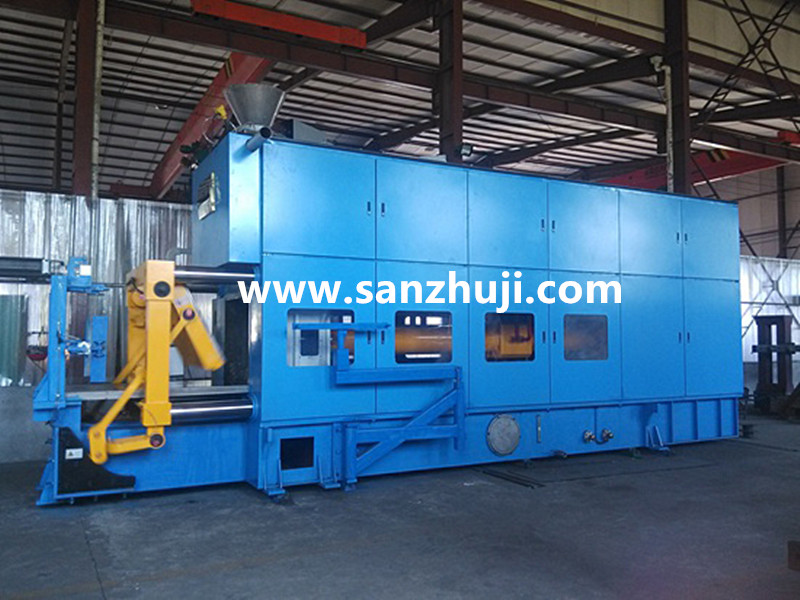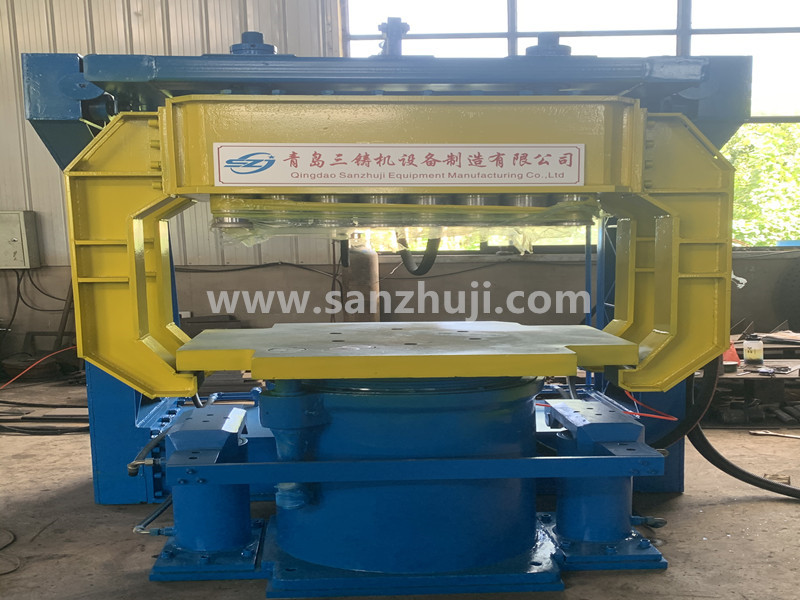For some companies, there are two extreme misunderstandings when using high-density molding lines: one is that there is no special difference between automatic molding and manual molding and general machine molding; the other is that automatic molding is relatively high-end, and the most used sand material is used. Good and brand new. These two ideas will cause certain troubles to the production of enterprises. According to Sanzhuji''''s years of corporate practice, it is believed that open-type linear molding sand is a quantitative change compared with hand-molded molding sand, while automatic linear molding sand is a qualitative change compared to the former. The former can judge whether molding sand is suitable for production based on production experience, hand grasping and eye observation, while the qualification of automatic linear molding sand requires various index data to support. Generally, foreign automatic molding machines will make regulations on these index data of molding sand. Some manufacturers It will also be very detailed. Some domestic automatic moulding machines do not have any information in this regard, so that some foundry manufacturers who first contacted automatic moulding machines have no basis. The commonly used indicators of the automatic molding line produced by sanzhuji are as follows:
1. Compaction rate 33%~42%: It is an indicator of the relative dryness and wetness of molding sand. No matter how much bentonite, coal powder and ash content in the molding sand, as long as the compaction rate is controlled within the required range, the hand feels dry. The degree of wetness is in the most suitable state, and it will affect the thickness of the sand mold, which is more obvious in vertical line production. Confirm that the final compaction rate should be at the top of the molding machine, generally sampling near the sand mixer. It is best to do several sampling comparisons between the sand mixer and above the molding machine to find the system difference between the two compaction rates. Finally, determine the data sampled at the sand mixer to facilitate operation.
2. Wet compressive strength 0.12MPa~0.2MPa: Wet compressive strength is an important indicator to ensure the normal progress of the molding and pouring process. High-strength molding sand can avoid collapse, expansion, and leakage, especially vertical production line sand molds should be promoted well. The sand mold moves forward, and there is no sand box to assist with the pressure of the molten metal during pouring, which will require higher strength of the sand. For example, for a vertical production line in a factory, the automatic molding machine requires the green sand strength of 0.2MPa~0.25MPa. In the first stage, the wet pressure strength is between 0.17MPa~0.18MPa, and sand hole defects account for 70-80% of the waste. After adjustment, the wet compressive strength was between 0.25 MPa and 0.27 MPa for several consecutive days, and the trachoma was reduced, and there was no trachoma for 4 consecutive days, but the stomata increased exponentially. It can be seen that the green compressive strength of molding sand is not as high as possible. Too high green compressive strength will reduce the permeability of the molding sand, increase the pore defects, increase the cost, and cause difficulty in falling sand. The placement of the test instrument will have a greater impact on the data of the wet compressive strength of the molding sand. Due to various conditions, some manufacturers place the instrument on the table or on the steel plate, especially the sample preparation machine. When the sample is hammered three times, it will be affected by the elastic force of the placed platform. The actual wet compressive strength is reduced by about 0.05MPa. Therefore, the test instrument should be placed on a platform rigidly connected to the ground, and the sample preparation machine should be disconnected from the placement plane of other test instruments.
3. Air permeability: horizontal line 90-130, vertical line 70-120. In production, the pursuit of high air permeability of molding sand is the goal of many people who do not fully understand molding sand. Although low permeability increases the porosity defects of castings, too high permeability can also make castings a waste product.
3.1. There are many pores in the first section of a horizontal production line, and the air permeability of molding sand has been stable at 110-130, but the manager thinks that the air permeability is not high enough, and instead of 70/140 raw sand, it is changed to 50/100 raw sand. After that, the air permeability of the molding sand gradually increased to 150-170, and the surface of the casting gradually became rough, reaching clusters of burrs. Individual castings could not completely remove the burrs. The prototype of the casting was restored, and it had to be rejected.
3.2. The vertical production line of a production plant, the air permeability of molding sand is ≤130, and the castings are located at the lowest part of the molding sand. There are many burrs. When asked why the air permeability is not reduced, the product supervisor thought that the air permeability is not as high as other production lines. He did not realize that the vertical and horizontal production lines have different requirements for the gas permeability of the molding sand due to the different positions of the gating system in the cavity.
4. Moisture: 2.8~3.4% for the horizontal line and 3.3~3.7% for the vertical line. In production, there are two common problems in the determination of moisture:
4.1. The weighing error of the sand moisture measured by the pallet balance can be as high as ±0.5%. It is best to use an electronic balance with a sensitivity of ±0.01g, and the maximum weighing is 200g.
4.2 When drying, the sample should be completely cooled to room temperature before weighing. Due to the water content of the old sand, activated sodium-based bentonite is commonly used in automatic lines. After this bentonite is mixed with water, it takes a certain time to reach the best strength value. More than 80% of the effective bentonite in the molding sand is present in the old sand. The moisture of the old sand is kept at about 60% of the moisture of the molding sand, which will make the mixing and grinding effect of the molding sand better.
5. The content of molding sand: 10-12% for the horizontal line and 11-13% for the vertical line include the effective bentonite, coal powder and dead ash. Among them, the effective bentonite and coal powder can guarantee the performance of the molding sand. The content is stable. If the total content increases, it indicates that the useless ash content increases. It increases the moisture content of the molding sand, decreases the permeability, and decreases the toughness. The quickest qualitative judgment data is the compaction rate/water content of the molding sand. It should be between 10 and 12. If this value is less than 10, it means that the inclusion is too high; if this value is> 12, the inclusion is too low. Directly related to the control of the content of molding sand is the dust removal capacity of the sand processing production line. The sand processing with good function has strong dust removal capacity and relatively fine classification. Generally, during normal production, it is adjusted once a year and can be adjusted in one month. In the rest of the time, minor adjustments will be made according to the changes in the sand content. There is also a considerable part of sand treatment dust removal at the highest level, but the content cannot always be reduced.
6. Effective pulverized coal content: Generally, the amount of pulverized coal is judged by the amount of gas generated by molding sand. Generally, the amount of gas generated by 1g of high-density molding sand is 16ml-24ml. Effective bentonite content: 5%-9%.
Case study: In a foundry workshop, a vertical parting production line produces small and medium-sized castings. The castings have serious sand hole waste. Molding sand: compaction rate 27%, wet compressive strength 0.26MPa, air permeability 55, moisture 3.75%, and content of 18.05%. The raw sand used is Zhengzhou Putian with a particle size of 70/140, and the particle size of the coated sand of the core used is also 70/140. If the compaction rate is too low, it will reduce the toughness of the molding sand and easily form blisters. From the above data analysis, the compaction rate of molding sand is too low, indicating that the moisture content in the molding sand should be increased compared with the effective water-absorbing substances in it, but the wet compressive strength is already very high at this time, and the moisture content is at the upper limit. When the actual rate is increased to 36%-37%, the strength will increase, and the most important thing is that the moisture will increase a lot, which is extremely unfavorable for controlling the porosity of the casting.
6.1 Observe the castings that have not been shot blasted. 40-50% of the surface of each casting has been separated from the molding sand, exposing the gray-blue surface;
6.2 Sand treatment and dust removal control is divided into five gears, which were only in the third gear at that time;
6.3 The original sand will not change the place of origin in the short term;
6.4 The amount of bentonite added is 1.4%, and the amount of coal powder added is 0.4%.
Based on the above reasons, sanzhuji makes the following suggestions:
(1). The sand processing dust removal is opened to the highest level, maintaining the strongest dust removal ability;
(2) The addition of bentonite is reduced to ~0.9%, and the addition of coal powder is reduced to less than 0.2%;
(3). Use 50/100 raw sand. After 20 days, the feedback information: compaction rate 36%, wet compressive strength 0.19MPa, air permeability ≤60, moisture ≤3.5%, content 13.2%, effective bentonite 8.3%, effective coal powder 6.2%. Among them, the air permeability is still very low because the 70/140 raw sand has not been used up, the coarse sand has not been replaced, and the amount of raw sand added is extremely low, other properties are relatively ideal, and the quality of castings has been greatly improved.
The above are just some of the situations that occurred in the production practice, and I will share them with you. If you can provide a little reference to the casting enterprises that are new to the high-density automatic molding line, it is very worthwhile. If you need foundry sand processing equipment, environmental protection dust removal equipment, and horizontal or vertical automatic molding machines, you can visit my factory.








